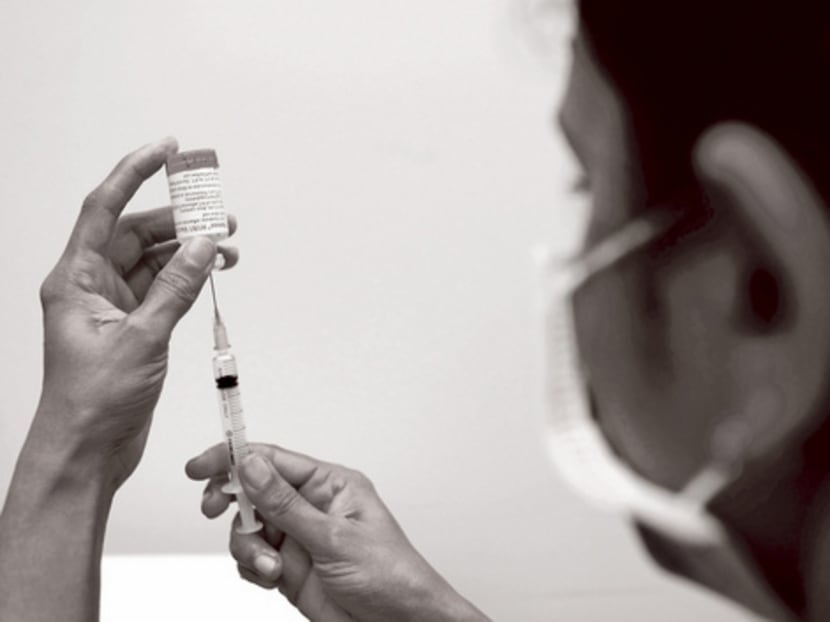Vaccines no longer just about efficacy
The Philippines recently rolled out the new CYD-TDV dengue vaccine, developed by pharmaceutical company Sanofi. This makes it the first country in Asia to do so.

There are a number of vaccines that can only reduce the number of infections. For endemic diseases such as dengue, the reduction in disease burden, despite a moderate efficacy, could still be substantial. TODAY file photo
The Philippines recently rolled out the new CYD-TDV dengue vaccine, developed by pharmaceutical company Sanofi. This makes it the first country in Asia to do so.
With an efficacy rate of just over 60 per cent, it is unlikely to match the success of established vaccines — such as the smallpox vaccine — that has led to the eradication of deadly diseases. But in this, the dengue vaccine is not unique.
There are a number of vaccines — new and established ones such as the influenza vaccine — that can only reduce the number of infections.
For endemic diseases such as dengue, which infects about 100 million people each year in more than 100 countries, the reduction in disease burden, despite a moderate efficacy, could still be substantial.
For policymakers, how the disease affects the population — the economic costs, hospitalisations and deaths caused by the disease — is the most important factor in setting priorities for any vaccine to be introduced into public-sector immunisation programmes.
Despite this, results from vaccine clinical trials focus on the regulatory concerns of vaccine efficacy and safety among individually vaccinated subjects.
While this data is crucial, vaccines do not just benefit individuals. They have the biggest impact when administered to whole populations.
Because clinical trials only provide concrete data on the impact of a vaccine on a relatively small subset of the population (trial participants), estimates of reduction in disease burden are best studied after the vaccine is licensed and rolled out in the population.
However, efficacy trials can provide an estimate of the potential public health impact, and such data should be reported to guide policymakers in evaluating the potential impact of a new vaccine.
In addition to the prevention of infection at the individual level, the introduction of vaccines into national programmes has to be driven by information on the vaccine’s impact on the population.
Hence, an additional measure that more directly establishes a vaccine’s public health importance is its preventable disease incidence (VPDI). VPDI is the number of infections in which a given disease syndrome is prevented by a vaccine in a given context.
Furthermore, the number needed to vaccinate (NNV) is often used as a metric of the value of vaccination programmes, and can also be used for cost-effectiveness studies. NNV is a measure to quantify the number of vaccines needed to prevent one case due to disease.
NNV provides a measure of immediate relevance to policy-makers, and such measures can also be used to calculate the cost-effectiveness of the intervention.
Both NNV and VPDI vary with the underlying pattern of the disease, such as the number of people typically affected, the severity of the disease, seasonality, age distribution and, where relevant, different strains of the virus.
Going back to the example of the CYD-TDV dengue vaccine, an analysis of the clinical trial data for VPDI and NNV published in Vaccine online showed that in Asia-Pacific, the vaccine prevented 2,639 cases of virologically confirmed dengue yearly for every 100,000 persons vaccinated, with an NNV of 18.
This means, over the two-year study period, 18 people had to be vaccinated to prevent one infection.
For people who required hospitalisation, the vaccine was able to prevent 638 hospitalisations due to dengue, and 290 hospitalisations due to severe dengue per 100,000 persons vaccinated per year, with NNVs of 75 and 166 respectively.
Comparing these results with data from other vaccines used in Asia, the dengue vaccine’s VPDI (290) for confirmed severe hospitalised cases was comparable with that (264) for the Hib vaccine, a standard childhood immunisation in Singapore against severe Hib pneumonia.
Worth noting is that the vaccine’s VPDI was not uniform across all types of dengue. The vaccine was able to inhibit the highest number of infections against DENV-4, followed by DENV-1. Clinical trial data also show that it was more effective in people who have had dengue before.
The World Health Organization’s Strategic Advisory Group of Experts on Immunisation, which just released its recommendation for the vaccine, stated that countries should consider introducing the vaccine only in geographic settings (whole country or regions) where dengue is very widespread.
While Singapore is bracing itself for another dengue spike this year because of unseasonable weather patterns, dengue is not yet as great a problem as it is in other South-east Asian countries such as Thailand or the Philippines.
The relatively lower levels of dengue in Singapore mean that fewer people here will have had previous exposure to the virus, something that appears to lower the efficacy of the vaccine.
Given that licensure is only sought for the age group of 9 to 45, and that the vaccine has an efficacy of around 60 per cent, the new dengue vaccine, even if introduced here, would obviously not be able to eliminate dengue in Singapore, although it is expected to reduce the overall numbers.
Other initiatives such as effective vector control, including regular fogging and the removal of stagnant water, will remain key and will have a wider benefit, potentially reducing the spread of other mosquito-borne diseases such as the Zika virus, should that start to circulate here.
The vaccine is currently under review with the Health Sciences Authority, and epidemiologists and modellers are trying to estimate the overall impact of this vaccine in the specific context of Singapore. A decision on whether to introduce the vaccine in Singapore is expected by October.
ABOUT THE AUTHOR:
Professor Annelies Wilder-Smith is Professor of Infectious Diseases and Lead for Global Health and Vaccinology at the Lee Kong Chian School of Medicine, Nanyang Technological University.






